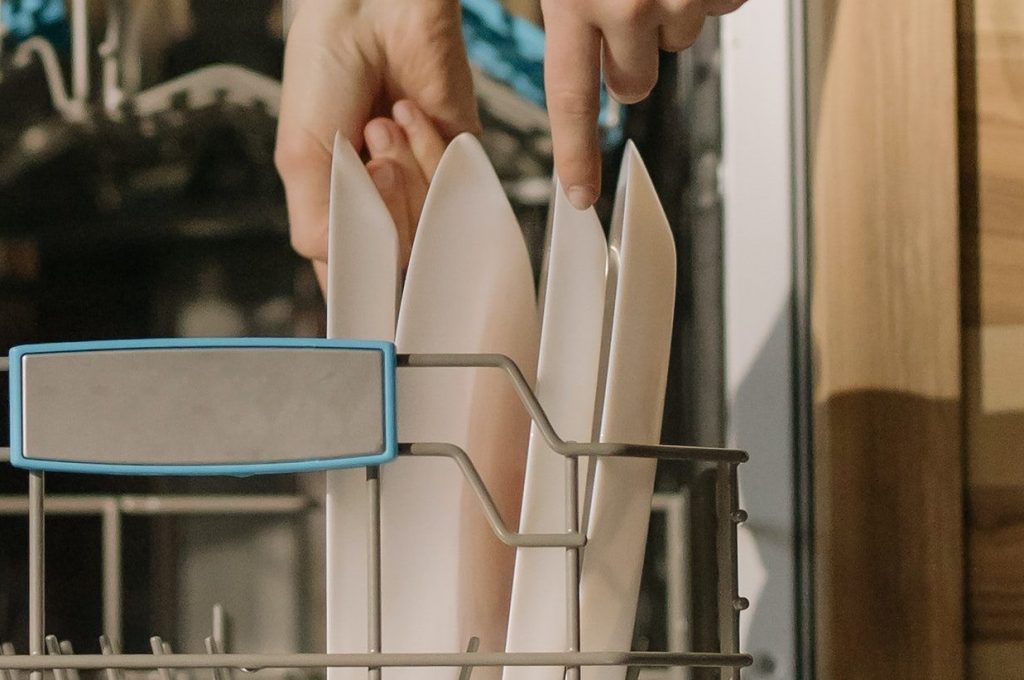Author of the blog. I am passionate about the calling to be a homemaker, and local, family-owned businesses.
Latest posts by Grace (see all)
- How to Make Ramen in the Microwave - July 1, 2025
- El Torito Corn Cake Recipe - July 1, 2025
- Air Fryer Frozen Fish Fillets No Breading - July 1, 2025
This page contains all the resources I have on dishwashers: how to choose a good dishwasher, install it, and use it effectively.
People Ask
What is a dishwasher?
Dishwashers are mechanical devices used for cleaning dishes, cutlery, and other kitchen utilities. They are made of stainless steel with racks that hold the dishes covered with plastic to prevent them from scratching the dishes. Dishwashers come in a variety of models and sizes, starting from the smallest in-sink dishwashers, over the standard ones, to the largest dishwashers used in commercial establishments. They are simply attached to the basin or, more often, to the kitchen cabinets. It is easy to use them – just load the dishwasher with dirty dishes, pour detergent, choose the right cycle, and let the machine do all the work. Besides cleaning, the dishwasher will also dry the dishes.
How long does a dishwasher run?
Dishwasher cycle time is between 1 and 4 hours. Since modern dishwashers use less energy and water, they require more time to ensure the same level of performance as older machines. Depending on the time they need to heat water, the hardness of water, how dirty the dishes are, type of cycle, and some other factors, cycle length can vary. Modern devices offer a minimum of 3 cycles – light, normal, and heavy but also eco, delicate, half load, and other options based on the dishwasher model. Keep in mind that each one has a different length.
How does a dishwasher work?
When water from the water supply is piped into a dishwasher, the machine starts spraying it at the dishes. Water temperature is 45-75 °C (110-170 °F), while for the delicate dishes machine uses lower temperature. An electric motor powers the pump that directs a mixture of hot water and detergent to the rotating spray arms. This mixture washes the dishes and, once the cleaning is finished, it gets drained. Freshwater comes to rinse the dishes. After it is drained, also by the pump, the drying process begins. Drying is done by the heat inside the dishwasher or by a heating element.
How long does a dishwasher last?
Dishwashers last about 10 years on average. If you are using your dishwasher according to its instruction manual and clean it properly, it can last even for a couple of decades! You can extend the life of your dishwasher by running it regularly, but it is recommended not to run it more than the average of 5 cycles a week. Using natural cleaning products like baking soda and vinegar to clean the dishwasher at least once a month helps it last longer and keeps it in a good condition.
How much water (gallons) of water does a dishwasher use?
An average dishwasher uses 6 gallons of water per cycle, while the Energy-star certified dishwashers are more efficient and use 3-4 gallons. Studies show that the dishwasher is more efficient than washing dishes by hand. Up to 27 gallons of water is used while washing dishes by hand per load, so it is estimated that you can save up to 5, 000 gallons of water per year by using a dishwasher instead. You can also save water if you:
- skip rinsing before putting the dirty dishes in the dishwasher,
- use a good quality detergent to ensure the dishes will always come out spotless,
- load a full dishwasher.
How hot does a dishwasher get?
Dishwashers use hot water with temperatures of 45-75 °C (110-170 °F). They are connected to the hot water line, so water gets heated before getting inside the dishwasher. Many devices also have a heating element that can increase the temperature. This is very important for dissolving detergent and for removing grease and oil. With this high temperature, you can be sure that your dishes are hygienically clean. Plus, this helps the machine be more time-efficient since hot water needs less time to clean the dishes. Dishwashers are designed to achieve a balance between effectiveness, speed, and economy.
How much power (amps and watts) does a dishwasher use?
Dishwashers use between 1200 and 2400 watts per cycle. On average a dishwasher uses 1800 watts of energy and consumes the power of 15 amps.
Energy-star certified dishwashers are eco-friendly and use less energy than standard models. On average, they use between 870 watts and 1590 watts per cycle.
New models usually come with heating elements that heat water more efficiently than water heaters. The dishwasher will use the same amount of energy through every cycle, so remember to fully load it if you want to save energy. Another tip is to leave the dishes to air dry after the dishwasher finished cleaning them.
Energy-star certified dishwashers are eco-friendly and use less energy than standard models. On average, they use between 870 watts and 1590 watts per cycle.
New models usually come with heating elements that heat water more efficiently than water heaters. The dishwasher will use the same amount of energy through every cycle, so remember to fully load it if you want to save energy. Another tip is to leave the dishes to air dry after the dishwasher finished cleaning them.
How do you use a dishwasher?
- Rinse the dirty dishes.
- Open the dishwasher.
- Load it.
- Put the detergent in the dispenser and close it.
- Close the dishwasher.
- Turn it on.
- Select the program.
- The machine will now start washing.
How do you clean a dishwasher?
- First, clean the dishwasher exterior using soap and water or a glass cleaner.
- Next, remove the filter that is located on the bottom rack. Rinse it under warm water.
- To clean the inside, use a clean cloth or a paper towels to wipe down and remove food scraps. Then run a hot water cycle to clean the machine using a cup of white vinegar instead of detergent. Additionally, you can sprinkle baking soda all over the bottom area and run another cycle with hot water. Once finished, wipe with a cloth or a paper towel.
How do you install a dishwasher?
- If you are installing the dishwasher for the first time you might need to drill 3 holes through the side of the cabinet – for the drain hose, water inlet and electrical wiring. Or use the existing ones if you are just replacing an old dishwasher.
- Turn off the water supply.
- Attach the drain hose to the main pipe below the sink.
- Connect the water line.
- Connect the dishwasher to the power supply.
- Put dishwasher into place.
- Turn on the water supply.
- Test the dishwasher.
- Ready to use.
How to load a dishwasher?
- Place pans, pots, bowls and plates on the bottom rack facing the spray nozzle. Lay them on the side with similar items next to one another.
- Load cups and glasses on the top rack facing down at an angle.
- Place spoons, forks and knives in their separate holder.
- Keep stainless steel and silver dishes separate to prevent corrosion.
- Keep plastic items secure and away from the bottom racks where they could melt.
- Leave space between the items and for water to run through. Do not overload!
How wide is a dishwasher?
Standard kitchen dishwashers are about 60 cm (24 in) wide. The width ranges from around 45 to 91 cm (18 to 36 in) for home dishwashers, while the commercial ones can be wider.
Which Dishwasher Should I Buy?
You can find my roundup of the five best dishwashers here. Spoiler: the Miele G4228SCUSS is the best all-around option.

